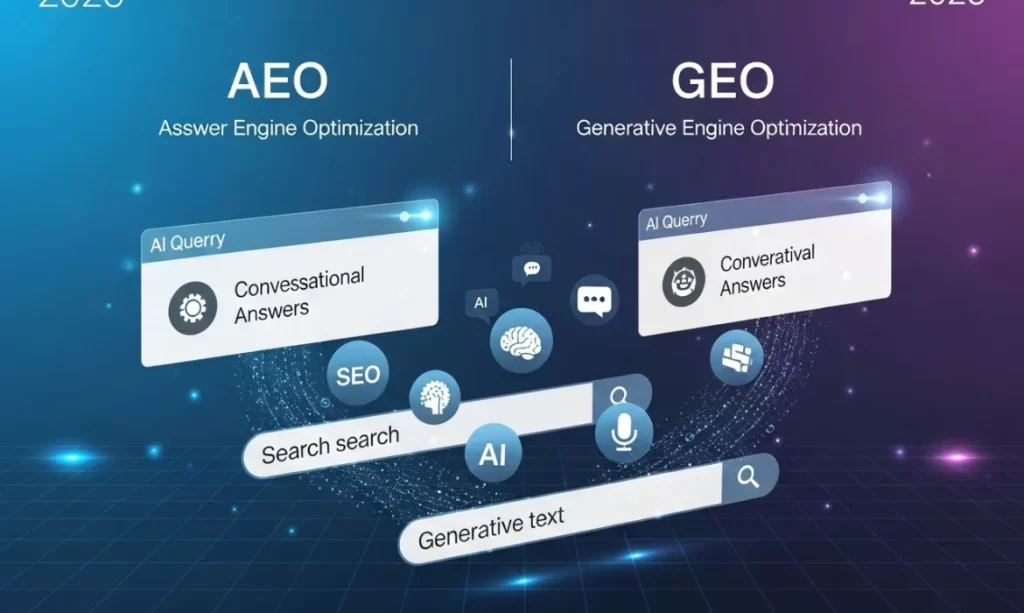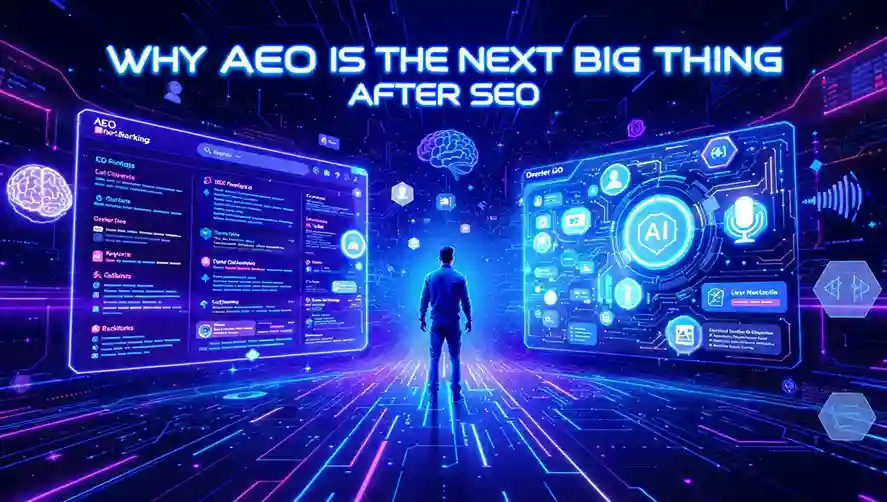
Navigating the AI Frontier: Your Guide to AEO & GEO in Google’s Wild New World
I. Intro: Goodbye Google Search, Hello Google Answer?
Remember the good old days when SEO revolved around the dance of keywords and the art of backlink acquisition? Those days, my friends, are relics, fading into the digital sunset like forgotten My Space profiles. Google’s metamorphosis is upon us, and if you’re clinging to outdated strategies, you’re essentially forfeiting your stake in prime online real estate.
The shift is tectonic: we’re transitioning from a mere search engine to a sophisticated answer engine. This paradigm shift demands a new approach – one where optimizing your content for direct answers, coveted featured snippets, and nuanced AI-powered summaries becomes paramount. Enter Answer Engine Optimization (AEO) and its geographically aware cousins, GEO (both Geographic and Generative!).
In this exploration, we’ll dissect the forces driving this change, unravel its multifaceted implications, acknowledge the inherent challenges, and, most importantly, equip you with the knowledge to not just survive, but thrive in this brave new world.
II. A Quick Trip Down Memory Lane: How Google Got So Smart
The seeds of Google’s answer-centric approach were sown long ago. Even in the distant digital past of 2005, Google began experimenting with “quick answers,” demonstrating an early awareness of our collective desire for instant gratification.
Then came the age of enlightenment, marked by the birth of the Knowledge Graph in 2012 and its visually appealing offspring, Knowledge Panels. Suddenly, a simple search for “Albert Einstein” didn’t just yield a list of links; it unveiled a curated summary of his life, accomplishments, and key facts, all neatly presented within the search results. Intriguingly, around 2017, Google even began empowering businesses to claim their Knowledge Panels, further blurring the lines between search results and branded content.
The evolution continued with the rise of Featured Snippets around 2015. These “quick answer boxes,” also known as “Position Zero,” elevated concise, directly-extracted content from websites, offering users readily digestible information without requiring a click-through. Lists, paragraphs, tables – Google essentially began spoon-feeding answers directly sourced from your website. Initially, this seemed like a boon for visibility, but a shadow of controversy was already beginning to form…
III. AEO & GEO: Your New Power Moves in Search
-
- Answer Engine Optimization (AEO): Your Content, Google’s Answer: AEO is about shaping your content to be the definitive, readily quotable answer for AI platforms such as Google’s AI Overviews, ChatGPT, and voice assistants. It’s a shift from the traditional focus on “ranking high” to a more nuanced objective: “being quoted authoritatively.”In an era dominated by AI, content that isn’t AI-friendly risks becoming irrelevant. AEO is about ensuring your expertise is not only seen but used, even if it’s just a fleeting mention within an AI-generated response.
-
- Geographic Local SEO (GEO): Own Your Neighborhood! Geographic Local SEO, or GEO, is about ensuring your business stands out when potential customers search for services in their vicinity. Think of it as local SEO amplified – targeting regions and countries rather than just specific streets. The essential ingredients include strategically incorporating localized keywords (e.g., “best vegan restaurant in Berlin“), meticulously optimizing your Google Business Profile, maintaining consistent business information across all online platforms, and ensuring your website is mobile-friendly for those ubiquitous “near me” searches.
-
- Generative Engine Optimization (GEO): The AI-Specific Twin! Yes, another GEO! Generative Engine Optimization (GEO) represents the cutting edge, focusing specifically on optimizing content for generative AI models like Google Gemini or Perplexity. The goal is to ensure that these AI models can not only understand your content but also cite and synthesize it accurately and effectively. The objective is not just to be the answer, but to be recognized as a trusted and authoritative source that the AI consciously references, even if users never directly visit your website. Think of it as influencing the AI’s very thought process.

IV. The Dark Side of Direct Answers: Zero-Clicks & Content Chaos
The rise of direct answers casts a long shadow, primarily in the form of the “zero-click” problem. Google has become so adept at providing answers directly within the SERP that users often find no need to click through to your website.
The data is stark: studies reveal that a significant proportion of searches – upwards of 65%! – now result in zero clicks. This trend has sent tremors throughout the content creation landscape, particularly affecting news sites and publishers, leading to dramatic declines in website traffic and associated ad revenue (with some experiencing losses of 30-70%).
The core question arises: Why invest in creating high-quality content if no one actually visits your site to consume it? Critics argue that Google is essentially gatekeeping traffic, hoarding it to boost its own ad revenue, and “stealing” content without providing fair compensation. Some even view it as an “existential threat” to the open web.
Furthermore, the reliance on AI-generated direct answers introduces the risk of errors and biases. Google’s algorithms, while sophisticated, are not infallible, and the absence of human oversight can lead to questionable or even demonstrably false results.
The most dire scenario involves a potential “content collapse.” If publishers are unable to monetize their content effectively, they may be forced to reduce or even cease production. This raises a troubling question: What will Google’s AI have to “answer” from if the well of original content dries up?
V. Mastering the AI Maze: Your AEO & GEO Playbook
-
- Think Like Your Audience (and the AI):Embrace the mindset of your audience – and the AI that serves them. Focus relentlessly on the questions that users are actually asking. “How to,” “what is,” “why does” – these are your gateways to AEO success. Craft direct, concise answers that get straight to the point. Aim for answers in the 40-60 word range for paragraph snippets. Prioritize clarity and accuracy by front-loading the most important information within the first 100-200 words.
-
- Format for Bots (and Humans!):Structure your content for optimal scanability, both for search engine bots and human readers. Employ question-based H1s, H2s, and H3s to facilitate easy indexing and understanding. Embrace lists – bullet points, numbered lists, and tables – as AI algorithms readily consume structured data. Develop dedicated FAQ sections to address common questions directly. Google loves this!
-
- Speak the AI Language: Schema Markup: Leverage schema markup as your secret code to communicate the essence of your content to Google. Employ
FAQPage,HowTo, andArticleschema types to enhance discoverability and understanding.
- Speak the AI Language: Schema Markup: Leverage schema markup as your secret code to communicate the essence of your content to Google. Employ
-
- Be a Trustworthy Guru (E-E-A-T):Prioritize Experience, Expertise, Authoritativeness, and Trustworthiness (E-E-A-T) in your content creation. Google (and AI) prioritizes high-quality, reliable information. Back up your claims with solid research, cite your sources meticulously, and cultivate your brand as a respected industry leader.
-
- Don’t Forget the Voice! Optimize your content for conversational, long-tail queries to improve its performance on voice assistants that frequently draw from featured snippets.
-
- For Generative GEO specifically: Break down complex topics into discrete, easily digestible “answer blocks” that align with common AI prompts. Cultivate off-page citations by seeking mentions on reputable websites. The more frequently you are cited, the more the AI algorithms will perceive you as an authority. Eliminate unnecessary fluff. AI algorithms prefer concise, direct language. Consider including a “TL;DR” (Too Long; Didn’t Read) summary for quick consumption.
VI. The Road Ahead: Google’s AI Future (and Yours!)
Google’s AI Overviews, powered by Gemini, are poised to become ubiquitous, rapidly displacing traditional featured snippets. Expect to see them appear in an increasing number of searches across the globe.
While AI Overviews offer more comprehensive answers, they are likely to exacerbate the zero-click problem, potentially resulting in an 18-64% reduction in organic clicks for some queries.
Google is moving towards an “AI Mode,” enabling users to engage in complex dialogues, ask follow-up questions, and even leverage AI for sophisticated planning tasks (such as generating meal plans or travel itineraries!).
Multimodal search is on the horizon, reducing reliance on typing and embracing voice, image, and interactive search experiences. Imagine asking questions about the content of a video!
Google is not alone in this race. ChatGPT (which held an 82.6% share of the AI search market as of July 2025), Perplexity, and Microsoft Copilot are all vying for dominance in the burgeoning “answer engine” space.
The lines between traditional SEO, AEO, and GEO will continue to blur. Success will hinge on creating personalized, high-quality content that AI trusts, cites, and leverages effectively. It’s about positioning yourself as the definitive source of information in a world increasingly defined by instant answers.
The call to action is clear: start optimizing your content for direct answers, structured data, and AI-friendly formatting now. Do not allow Google’s relentless evolution to leave your website stranded in the digital dust.
VII. Conclusion: Adapt or Be Left Behind!
The search landscape has undergone a profound and irreversible transformation. AEO and GEO are no longer mere buzzwords; they represent essential strategies for achieving visibility in the age of AI.


Leave a Reply